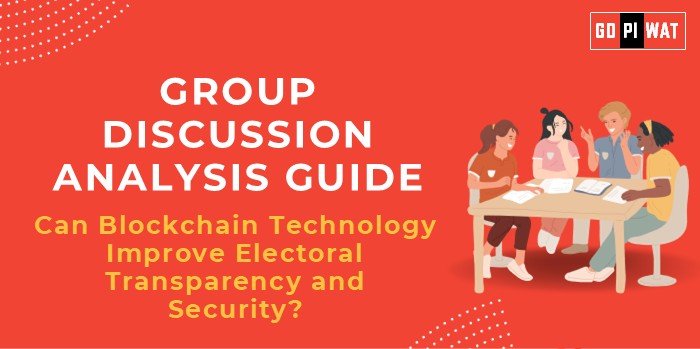📋 Group Discussion (GD) Analysis Guide: Can Blockchain Technology Improve Electoral Transparency and Security?
🌐 Introduction to the Topic
- Opening Context: “In an era of increasing digital adoption, electoral integrity is a cornerstone of democratic governance. Blockchain, with its promise of transparency and immutability, presents a revolutionary potential to transform electoral systems.”
- Topic Background: Blockchain is a distributed ledger technology that ensures tamper-proof data recording. It has garnered attention for its potential applications in various domains, including finance, supply chain, and now elections. Countries like Estonia and Switzerland have explored its usage in e-voting systems, sparking debates about its feasibility and impact.
📊 Quick Facts and Key Statistics
- 🌐 Global Blockchain Adoption: Expected market growth of 66.2% CAGR from 2023 to 2030 showcases increasing reliance on blockchain for secure systems.
- 🗳️ E-Voting Pilots: Estonia has integrated blockchain-based e-voting in its elections, ensuring 100% transparency.
- ⚠️ Election Frauds: According to a UNDP report, 45% of global democracies face election manipulation concerns.
- 📡 Digital Inclusion in India: With over 900 million internet users, India’s potential for blockchain integration in electoral systems is immense.
👥 Stakeholders and Their Roles
- 🏛️ Election Commission: Oversee blockchain adoption, ensure system integrity, and policy frameworks.
- ⚖️ Government Bodies: Allocate funds and draft regulations supporting secure digital transitions.
- 💻 Tech Companies: Develop and implement blockchain systems tailored to electoral needs.
- 🗳️ Voters: Engage with the technology, providing feedback for system usability.
- 🤝 Civil Society and NGOs: Monitor adoption and provide accountability measures.
🏆 Achievements and Challenges
✨ Achievements:
- 🔒 Immutable Record-Keeping: Blockchain ensures unalterable voting records.
- 📜 Transparency Boost: Real-time audit trails enhance trust in electoral processes.
- 🌍 International Success: Estonia’s e-voting model demonstrates increased voter participation.
- 💰 Cost-Efficiency: Long-term savings from reduced physical infrastructure.
⚠️ Challenges:
- 🌐 Digital Divide: Limited internet penetration in rural areas.
- 🔓 Cybersecurity Threats: Systems remain vulnerable to advanced hacking attempts.
- 💸 Implementation Costs: High initial investments in infrastructure.
🌍 Global Comparisons:
- 🇪🇪 Estonia: Blockchain successfully used since 2005, ensuring voter accessibility globally.
- 🇨🇭 Switzerland: Local referendums use blockchain but face challenges of scalability.
📚 Case Studies:
- 🇮🇳 Kerala: India’s blockchain-driven pilot for supply chain transparency could serve as a model for electoral systems.
📋 Structured Arguments for Discussion
- 👍 Supporting Stance: “Blockchain can revolutionize electoral transparency by providing immutable records and real-time audits, ensuring trust in elections.”
- 👎 Opposing Stance: “Despite its promise, blockchain is limited by high costs and vulnerabilities to sophisticated cyberattacks.”
- ⚖️ Balanced Perspective: “Blockchain offers immense potential, but its success requires addressing cybersecurity and digital access challenges.”
💬 Effective Discussion Approaches
- Opening Approaches:
- 📂 “With concerns about electoral fraud rising globally, blockchain could be the trust-building tool democracies need.”
- 📊 “The digital divide poses a critical barrier to blockchain adoption in elections, raising questions about inclusivity.”
- Counter-Argument Handling:
- 🔒 Acknowledge security issues but highlight ongoing advancements in cryptography to mitigate risks.
- 🛠️ Stress pilot programs to test scalability and inclusivity.
🔍 Strategic Analysis of Strengths and Weaknesses
- 💡 Strengths: Transparent systems; efficient auditing mechanisms.
- ⚠️ Weaknesses: High costs; vulnerability to cyber threats.
- 🌟 Opportunities: Global leadership in e-governance; enhanced voter trust and participation.
- ⚡ Threats: Resistance to change; potential misuse of technology.
🎓 Connecting with B-School Applications
- 📖 Real-World Applications: Case studies in blockchain’s role in finance and governance offer project opportunities in strategy and tech management.
- 🤔 Sample Interview Questions:
- How would you address digital access issues for blockchain-based voting in India?
- Compare blockchain’s application in finance and governance.
- 📚 Insights for B-School Students:
- Explore interdisciplinary projects combining technology and public policy.
- Analyze blockchain startups for innovative approaches to governance.
📄 Source: GD and WAT preparation frameworks, 2024.


